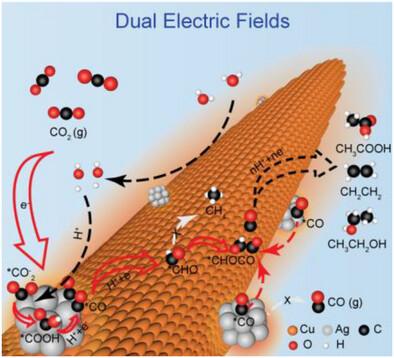双电场富集和稳定中间体,用于高效电化学CO2还原成多碳产品
IF 19
1区 材料科学
Q1 CHEMISTRY, MULTIDISCIPLINARY
引用次数: 0
摘要
电化学还原CO2是一项在可再生能源储存和减缓气候变化方面具有巨大潜力的技术,它依赖于CO2RR中关键的C─C耦合步骤,以确保高效的高价值碳氢化合物生产。本文在银包埋的Cu纳米针阵列上构建了局部界面电场和针尖感应电场,分别提高了*CO中间体的浓度和调节了关键中间体的吸附。优化的反应微环境促进了*CO中间体深度还原成多碳产物(C2+),法拉第效率为83.7%,C2+局部电流密度为- 526 mA cm - 2。实验和模拟结果表明,Cu - Ag双金属催化剂的界面电场增加了表面*CO的覆盖率,大大降低了*CHO中间体的形成屏障,而尖端感应电场可以稳定*CO中间体并抑制氢的析出,促进了C─C耦合过程。双电场的形成深刻地诱导了局部环境并最终主导了C2+产物,这为调节反应中间体的供需平衡提供了重要的设计指导。本文章由计算机程序翻译,如有差异,请以英文原文为准。

Dual Electric Fields Enrich and Stabilize Intermediates for Efficient Electrochemical CO2 Reduction to Multi‐Carbon Products
Electrochemical reduction of CO2 , a technology with great potential for renewable energy storage and climate change mitigation, depends on critical C─C coupling steps in CO2 RR to ensure efficient high‐value hydrocarbon production. In this work, a local interface electric field and a tip‐induced electric field are constructed on Ag‐embedded Cu nanoneedle arrays to enhance the concentration of the *CO intermediate and regulate the adsorption of key intermediates, respectively. This optimization of the reaction microenvironment promotes the deep reduction of the *CO intermediate into multi‐carbon products (C2+ ), with a faradaic efficiency of 83.7% and a C2+ local current density of −526 mA cm−2 within gas‐fed flow cells. Experimental evidence and simulations validate that the interface electric field of the Cu‐Ag bimetallic catalyst increased surface *CO coverage, substantially lowering the formation barrier for *CHO intermediate, and the tip‐induced electric field that can stabilize *CO intermediate and suppress hydrogen evolution, promoting the C─C coupling process. The formation of the dual electric fields profoundly induced local environments and ultimately, the dominant C2+ product, which offers significant design guidelines for adjusting the supply and demand balance of reaction intermediates.
求助全文
通过发布文献求助,成功后即可免费获取论文全文。
去求助
来源期刊

Advanced Functional Materials
工程技术-材料科学:综合
CiteScore
29.50
自引率
4.20%
发文量
2086
审稿时长
2.1 months
期刊介绍:
Firmly established as a top-tier materials science journal, Advanced Functional Materials reports breakthrough research in all aspects of materials science, including nanotechnology, chemistry, physics, and biology every week.
Advanced Functional Materials is known for its rapid and fair peer review, quality content, and high impact, making it the first choice of the international materials science community.
 求助内容:
求助内容: 应助结果提醒方式:
应助结果提醒方式:


